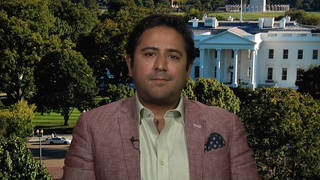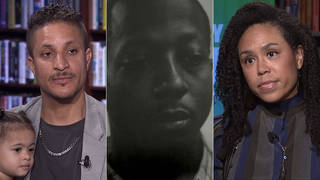
Guests
- Christie Thompsonstaff writer at The Marshall Project. Her new story is headlined “From Solitary to the Street: What Happens When Prisoners Go from Complete Isolation to Complete Freedom in a Day?”
- Five Mualimm-akhuman rights and prison reform advocate, founder of Incarcerated Nation Collective, a collective of previously incarcerated people. He was formerly incarcerated and spent 11 years in New York’s prison system for criminal weapons possession and other charges. During that time, he was held in solitary confinement for a total of five years.
The Department of Justice estimates that about 80,000 prisoners are in solitary confinement. Some have been held in isolation for decades. Former Black Panther Albert Woodfox has been in solitary for over 40 years. While Woodfox could be released as early as today, we look at a new investigation by The Marshall Project and NPR that reveals prisons are sending thousands of people directly from solitary confinement back into their communities with almost no help or preparation. Many wind up homeless or back in prison. We speak to Christie Thompson of The Marshall Project and Five Mualimm-ak, founder of Incarcerated Nation Collective, a collective of previously incarcerated people. He spent 11 years in New York’s prison system, including five years in solitary.
Transcript
AMY GOODMAN: “Almost Free” by Sarah Quintana, a New Orleans artist who was a pen pal with the late Herman Wallace, member of the Angola Three who was held in solitary confinement for more than 40 years. He died three days after his release from prison in Louisiana last October. In our next segment, we’ll talk more about the last member of the Angola Three, who could be freed today as early as this afternoon. Yes, this is Democracy Now!, democracynow.org, The War and Peace Report. I’m Amy Goodman.
The release of former Black Panther Albert Woodfox, the longest-serving U.S. prisoner in solitary confinement, could come as early as this afternoon. On Monday, a federal judge ordered Louisiana to immediately release Woodfox, who is now 68 years old and was first placed in solitary in 1972 after he was charged in the murder of a prison guard. Woodfox is a member of the Angola Three and a former Black Panther who says he was falsely accused of killing a prison guard because of his political organizing. Despite the judge’s extraordinary ruling, Woodfox’s release was delayed when Louisiana appealed to the Fifth Circuit.
Meanwhile, here in New York, hundreds of people rallied outside a Manhattan jail last night to remember Kalief Browder. In 2010, at the age of 16, Kalief was arrested after being accused of stealing a backpack. He would spend three years at New York City’s Rikers Island jail, more than two of those years in solitary confinement. After a judge finally dismissed the case against him and he was released—he had refused repeated offers of plea bargain, saying he wanted to go to court to prove his innocence—Browder tried to reclaim his life, after three years in prison. He wound up going to community college. But in the end, the nightmare he lived through overwhelmed him. This past Saturday, 12 days after his 22nd birthday, Kalief Browder wrapped an air conditioner power cord around his neck and hanged himself. According to the New York Daily News, Browder killed himself just days before he was scheduled to appear in court on charges described by his lawyer as “baseless.”
Nationwide, the Department of Justice estimates that about 80,000 prisoners are in solitary confinement. Today, we look at a new investigation by The Marshall Project and NPR that reveals prisons are sending thousands of people directly from solitary confinement back into their communities with almost no help or preparation. In the state of Texas, for example, only 14 percent of prisoners in the general prison population were released without supervision. But for those sent home from solitary confinement, that number rose to 63 percent. Many wound up homeless or back in prison.
For more, we’re joined by two guests. Christie Thompson is staff writer at The Marshall Project. Her new story is headlined “From Solitary to the Street: What Happens When Prisoners Go from Complete Isolation to Complete Freedom in a Day?” Also with us is Five Mualimm-ak, a human rights and prison reform advocate, founder of Incarcerated Nation Collective, a collective of previously incarcerated people. He was formerly imprisoned and spent 11 years in New York’s prison system for criminal weapons possession and other charges. During that time, he was held in solitary confinement for a total of five years.
We welcome you both to Democracy Now!
FIVE MUALIMM-AK: Thank you.
AMY GOODMAN: I want to begin with you, Christie. Talk about what you found.
CHRISTIE THOMPSON: So, what I and NPR set out to do was find out how often prisons were taking someone from solitary confinement, where they’re locked down 23 hours a day, almost no human contact, and then releasing them the very next day back to their families. So we reached out to all 50 corrections departments and found that in 24 states last year over 10,000 people were sent straight from segregation back to their community. But what was even more striking was that 26 states and the Federal Bureau of Prisons actually couldn’t tell us how often that was happening.
And we talked to many people who had had this experience, and what was really interesting was how similar many of their stories were. They had a fear of crowds. They had difficulties dealing with anger and anxiety. And like you mentioned, many—in several states, these people are actually more likely to be released without any supervision. So, in many ways, the prisoners that need the most help and support after coming home from prison are actually getting the least.
AMY GOODMAN: So, what trouble did you have in gathering data?
CHRISTIE THOMPSON: So, as anyone who’s dealt with solitary confinement knows, states define how they use segregation very differently, and they track it very differently. So some states could only give us the number of people that were held in what’s known as administrative segregation, which are cells that they use for alleged gang members or people that they deem a threat to security. Other states gave us everyone that was released from any kind of segregation, be it disciplinary or allegedly protective segregation for an inmate’s own safety. So we couldn’t really compare the numbers. And, like I said, 26 states said, “We don’t keep track of that data. It would cost us thousands to provide it to you.” So that was a real problem, is that many states just didn’t know.
AMY GOODMAN: Can you tell us the story of Mark and Brian?
CHRISTIE THOMPSON: So, Mark is a family—we spent a lot of time with his mother, Sara Garcia, down in Austin, and he first entered the criminal justice system when he was 14 for armed robbery. And even when he was in juvenile detention, psychologists there recognized that Mark had a long history of mental illness—anger issues, schizoaffective disorder, emotional disturbance. And his psychologists there said this is someone who really needs intensive treatment and life skills training.
And instead what happened is, when he was 18, he was moved to a maximum-security adult prison and very quickly ended up in a segregation unit because his cellmate told guards that he was threatening to run away. And Mark’s family talked about how they really watched him, even though he had always had these issues, deteriorate even further. And he was there because the prison thought he was going to escape, and they held him right until the day of his release.
So, in July, Mark came out of prison having spent the last two-and-a-half years without any human contact, basically sitting by himself in a cell. And his mother said that she felt that day like relief, that she thought, you know, things were going to get better, she can start helping her son. But actually, for their family, that was when a lot of the problems began.
AMY GOODMAN: At a 2012 Senate hearing, psychologist and solitary confinement expert Dr. Craig Haney testified about how inmates may have trouble adjusting to life after solitary confinement.
DR. CRAIG HANEY: One of the very serious psychological consequences of placing people in solitary confinement for long periods of time is that it renders many people incapable of living anywhere else. In other words, they have to transform themselves—their habits of being, their ways of acting and thinking and relating to themselves as well as the world—premised on—premised on the assumption that they will not be around other human beings. And they actually get to the point where they find that it is frightening to be around other people. Many of the people who I work with who come out of solitary confinement and go either into mainline prisons or come out into free society talk about being anxious, overcome, overwhelmed with anxiety, when they’re around other human beings, because they become accustomed to be—to being isolated or being alone.
AMY GOODMAN: That’s Dr. Craig Haney testifying before the Senate. Exonerated Texas death row prisoner Anthony Graves also testified before the Senate at this 2012 hearing. He spoke about the self-mutilation carried out by prisoners in solitary confinement. And a warning to our listeners and viewers, this is very graphic.
ANTHONY GRAVES: I watched men literally self-mutilate themselves. They had to be put on razor restrictions, because if they’re given a razor, they will cut their own throat, their own neck, wherever they could cut at on their own bodies. They just stand there in front of you and cut themselves. And this one man in particular that I watched do this, they took him over to what they call the psychiatric ward. A few days later, he hung himself, all because of the conditions. There’s a man right there sitting on Texas death row right now who’s housed in solitary confinement, pulled his eye out and swallowed it—all because of the conditions. Solitary confinement dehumanizes us all.
AMY GOODMAN: Exonerated Texas death row prisoner Anthony Graves testifying before the Senate at this 2012 hearing. We are joined also by Five Mualimm-ak. You spent, what, close to five years in solitary confinement here in New York. Talk about your experience, why you would be put in solitary confinement. Does what Anthony Graves described ring true for you, these horrific circumstances?
FIVE MUALIMM-AK: Yes, Anthony is a very good speaker, but also speaks from experience, his time in solitary as a death row. It also—he also revolutionarily brought the connection of death row people confined into normal people confined into solitary, not into those conditions, how similar they are.
In solitary, you experience a few things—one, sensory deprivation, and, two, my self human validation, which is missing, right?—and how important that is for us. How do we receive information? How do we communicate with others? We’re very social creatures. Solitary deprives you of all of that. There is no skills to use, so you don’t use that.
The most egregious punishment, because we always think of solitary as the worst of the worst, the Hannibal Lecters of the world, and this is “we have to keep these people confined, or else they’ll just jump up and bite your face off”—but that is just not true. The New York Civil Liberties Union did a “Boxed In” report, and they revealed that five out of six tickets were for nonviolent disciplinary infractions, right? And the disciplinary infractions are based on your behavior, so people with mental illness who behave outright are higher in there.
I found over the years the solitude brought more damage to my everyday actions in how I relate to other people, how do I talk—right?—remembering how to smile when a person looks at you, you know, or the importance of somebody hearing you or not paying attention to you. It enrages you, right? The point of being ignored enrages you. And then they drop you off at 42nd Street at Times Square. You’ve got Spider-Man fighting the Statue of Liberty, 20 million commuters, and you get off the bus from an isolated cell, right? No social skills, no communication.
And majority of people, 50 percent of people, commit suicide. We suffer from depression and live through those moments. If you can’t take your life because you’re restricted from it, now that you’re finally free, those options are a little different. And the warning signs—there’s plenty of opportunities to see warning signs from people when they come home. Those were ignored, like in the case of Kalief. Totally ignored that he was hearing voices, right? That is a form of schizophrenia. I mean, I suffer from schizophrenia. My son suffers from schizophrenia. It’s a different form when you’re isolated in a box and then you’re suddenly into the loudest city in the world—it’s a different form of attack on you. And people live with these invisible scars every day, struggle. Right down the block from here, three people committed suicide coming home directly from solitary, jumping off the roof of the shelter. This is something that if we don’t address, we’re never going to end mass incarceration or incarceration, period.
AMY GOODMAN: Last year, I interviewed Lance Lowry, president of AFSCME Local 3807 of Texas Correctional Employees, the union which represents Texas prison employees, the guards. He explained why he had written an open letter to Texas prison officials, calling on them to reduce the use of solitary confinement.
LANCE LOWRY: When you place somebody in solitary, you lose a lot of management control over that person. There’s not much more you can do. And, you know, correcting bad behavior at that point is—it’s not a positive step. You don’t have the steps and the ability to correct negative behavior. Plus you have the aspects, increased exacerbation of mental health issues. I’ve seen offenders cut on themselves, go to the point of even rubbing feces on theirselves due to the rapid deterioration. There’s no sensory stimulation in these cells, and that creates a major problem.
AMY GOODMAN: So, this is very interesting, because he’s head of the union that represents the guards.
FIVE MUALIMM-AK: Right. Well, you know, it’s an environment that affects everyone, right? So you can’t just say the public safety for these people incarcerated, you can’t just say public safety for the community that is negligent to their returning and to the lack of training or therapy or even empathetic or sympathetic support for these people coming out. But also, who is trapped in the environment while these people are going through these same emotions? They’re trapped in, too. They do sentences, 10, 20 years, eight hours at a time, right? And they go through social emotional skills because they’re trained not to speak to anyone. They’re trained not to keep eye contact with people. They’re trained to not call people by their name, but by numbers, to recognize them as bodies. So these people are trained, because if you were human, and you looked at a person as a human, and you called him as a recognizable name, not an inmate, not a convict, but a person incarcerated, then it would cause you to reflect on yourself and treatment that you would want to receive, right?
AMY GOODMAN: How are you organizing people coming out not only of prison, but how are you helping people coming from solitary to freedom?
FIVE MUALIMM-AK: Well, we try to monitor those inside and help them through getting the—starting the process from the inside. That’s the problem, right? There is no communication. There is no connection. There is no phone call abilities. There’s no visit abilities. So you cannot properly prepare for your own release.
What we’ve helped inspire positions—we actually—people previously incarcerated now possess all the positions of re-entry in the state. So, like, my co-worker, Johnny Perez, he’s a safe re-entry advocate—in other words, helping people with mental illness re-enter society—because he’s been through it. He knows the ropes, right? So we’ve created a whole re-entry advocate network that is manned and womanned and supported by those who have been through the experience, know the hardship of reintegration, know the lack of programs—right?—know that chronic homelessness excludes you from being able to be housed when you come out. You’re not even considered homeless. You’re considered homeless for one day, if you did all the time in prison that you’ve done.
So these laws have to change, but until then, we have to support those. And we create projects to support, but also guide, right? That we need psychological assessments when people come home that day, not make it to parole by 5:00, not somehow navigate through the entire New York system and go get your services in Queens at the end by the airport, none of that. We have to actually treat people like humans, meet them when they come out of the train station, and guide them to their appointments and help them get the psychological care and support that they need, not just one day, but continuing afterwards.












Media Options